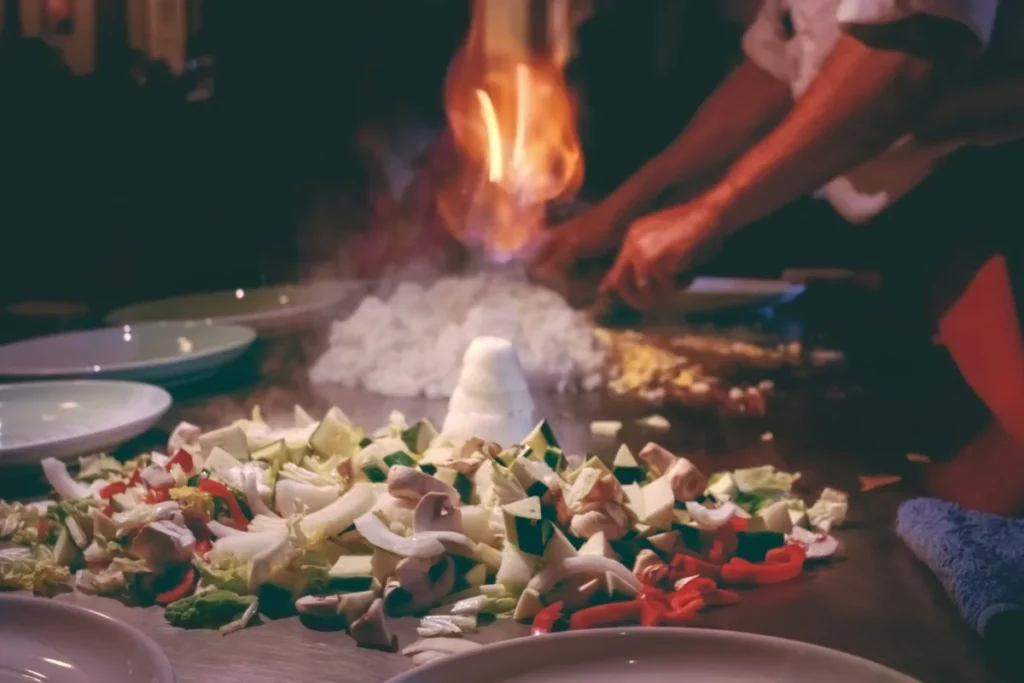Get ready to embark on a sizzling journey into the world of teppanyaki! This unique culinary experience is more than just a meal; it’s a captivating performance that tantalizes your taste buds and leaves you in awe. From the skilled chefs who masterfully chop and grill on a hot iron surface to the fresh, flavorful ingredients that sizzle before your eyes, teppanyaki offers a feast for all senses.
In this comprehensive guide, we’ll delve into the intricacies of teppanyaki, exploring its origins, essential elements, popular dishes, and even ways to recreate the magic at home. So, whether you’re a seasoned teppanyaki enthusiast or a curious newcomer, prepare to be captivated by the art of iron griddle cooking!
Introduction
What is Teppanyaki?
Teppanyaki, a term that translates to “iron plate grilling,” refers to a Japanese style of cooking where chefs prepare food on a large, flat iron griddle. The origins of teppanyaki can be traced back to the 1940s in Japan, where it initially focused on Western-influenced dishes like steak and seafood. However, teppanyaki quickly evolved into a distinctive culinary art form that incorporates traditional Japanese flavors and techniques.
Now, let’s clear up a common misconception: teppanyaki and hibachi are not the same. While both involve cooking on a hot surface, hibachi uses a charcoal grill with an open grate, whereas teppanyaki employs a flat iron griddle. This fundamental difference leads to variations in cooking techniques and the overall dining experience.
The Teppanyaki Experience
A teppanyaki dinner is an immersive experience that goes beyond simply enjoying delicious food. Imagine yourself seated around a large iron griddle, anticipation building as the chef arrives with a cart laden with fresh ingredients. The chef, a master of their craft, takes center stage, showcasing their culinary skills with impressive knife work, perfectly timed flips, and perhaps even a playful trick or two.
The sizzling sounds, tantalizing aromas, and the chef’s engaging performance create an unforgettable dining experience. It’s not just about the food; it’s about the showmanship, the interaction, and the shared enjoyment of a culinary adventure.
Key Elements of Teppanyaki
The Teppanyaki Grill
The heart of teppanyaki lies in its namesake – the teppan. This flat, iron griddle provides a smooth and even cooking surface, essential for achieving the characteristic searing and caramelization of teppanyaki dishes. The intense heat of the teppan allows chefs to cook food quickly while retaining its natural flavors and juices.
Teppanyaki grills come in various sizes and styles, typically fueled by gas or electricity. Modern teppans often feature built-in ventilation systems to whisk away smoke and maintain a comfortable dining environment. Whether it’s a large communal grill at a restaurant or a compact countertop version for home use, the teppan is the stage upon which the teppanyaki magic unfolds.
Essential Ingredients
Teppanyaki cuisine emphasizes fresh, high-quality ingredients that shine through the simplicity of the cooking methods. The star players often include:
- Meats: Tender cuts of steak, such as filet mignon or ribeye, are teppanyaki favorites. Chicken, particularly boneless, skinless breasts or thighs, is another popular choice. For a taste of Japanese tradition, thinly sliced Wagyu beef offers a luxurious and melt-in-your-mouth experience.
- Seafood: From succulent shrimp and scallops to tender lobster and flaky fish like salmon or tuna, seafood takes center stage in many teppanyaki dishes. The quick cooking time on the teppan ensures that seafood retains its delicate texture and fresh flavors.
- Vegetables: A colorful array of vegetables adds vibrancy and nutritional balance to teppanyaki meals. Broccoli, carrots, onions, mushrooms, and zucchini are commonly used, often chopped into bite-sized pieces for easy cooking and eating.
- Sauces and Condiments: Teppanyaki wouldn’t be complete without its flavorful sauces and condiments. Soy sauce, teriyaki sauce, garlic butter, and ginger sauce are popular choices, adding depth and complexity to the grilled dishes.
Teppanyaki Cooking Techniques
Teppanyaki chefs are not merely cooks; they are skilled performers who wield their tools with precision and flair. Knives and spatulas become extensions of their hands as they chop, slice, and maneuver food across the hot teppan.
Some of the essential teppanyaki cooking techniques include:
- Chopping and Slicing: Chefs showcase their knife skills by quickly and efficiently chopping vegetables and slicing meats into uniform pieces, ensuring even cooking.
- Griddling: The teppan’s high heat allows for rapid searing, locking in juices and creating a flavorful crust on meats and seafood.
- Stir-frying: Vegetables and other ingredients are expertly tossed and stir-fried on the teppan, ensuring they are cooked to perfection while maintaining their crispness.
- Seasoning: A sprinkle of salt, pepper, or a dash of soy sauce enhances the natural flavors of the ingredients, while the chef’s intuition guides the perfect balance of seasonings.
Popular Teppanyaki Dishes
Classic Teppanyaki Options
The sizzling world of teppanyaki offers a diverse range of dishes to tantalize every palate. Here are some of the classics that grace the menus of teppanyaki restaurants worldwide:
- Steak: From tender filet mignon to juicy ribeye, teppanyaki steak is a true showstopper. Chefs expertly sear the steak to the desired doneness, creating a flavorful crust while keeping the interior succulent and juicy.
- Shrimp: Plump and succulent shrimp are a teppanyaki staple, often cooked with a touch of garlic butter and a squeeze of lemon for a simple yet elegant preparation. The quick cooking time on the teppan ensures that the shrimp remains tender and flavorful.
- Chicken: Boneless, skinless chicken breasts or thighs are versatile options for teppanyaki. They can be marinated in teriyaki sauce or simply seasoned with salt and pepper before being grilled to perfection. The teppan’s high heat creates a slightly crispy exterior while keeping the chicken moist and tender.
- Vegetables: A vibrant medley of vegetables adds color, texture, and nutrients to any teppanyaki meal. Broccoli, carrots, onions, mushrooms, and zucchini are common choices, often cooked with a touch of soy sauce or sesame oil to enhance their natural flavors.
Beyond the Basics
While steak, shrimp, chicken, and vegetables form the core of teppanyaki cuisine, the possibilities extend far beyond these classics. Here are a few additional options to explore:
- Fried Rice: Teppanyaki fried rice is a crowd-pleaser, combining fluffy rice with a mix of vegetables, egg, and often protein like chicken or shrimp. The teppan’s even heat distribution ensures that the rice is cooked to perfection, with each grain separate and flavorful.
- Noodles: From yakisoba to udon, noodles can also be prepared on the teppan, offering a satisfying and flavorful alternative to rice. The noodles are typically stir-fried with vegetables and a savory sauce, creating a delicious and comforting dish.
- Seafood Combinations: Teppanyaki restaurants often offer combination platters featuring a variety of seafood, such as lobster, scallops, and fish. These combinations allow diners to sample a range of flavors and textures, all expertly prepared on the teppan.
Whether you prefer the simplicity of classic grilled meats or the complexity of seafood combinations, teppanyaki offers something for everyone. The key lies in the freshness of the ingredients, the skill of the chef, and the captivating experience of watching your meal come to life on the sizzling teppan.
Teppanyaki at Home
Bringing Teppanyaki to Your Kitchen
You don’t have to visit a fancy restaurant to enjoy the thrill of teppanyaki. With a little creativity and the right tools, you can recreate the magic of iron griddle cooking in the comfort of your own home.
Several options exist for home teppanyaki enthusiasts:
- Countertop Teppanyaki Grills: These electric grills are designed specifically for teppanyaki-style cooking, offering a flat cooking surface and adjustable temperature controls. They are perfect for small gatherings or individual meals, allowing you to enjoy teppanyaki anytime you desire.
- Adaptable Griddles: If you have a flat-top grill or a large cast-iron skillet, you can easily adapt them for teppanyaki cooking. Ensure the surface is clean and well-seasoned, and you’re ready to start grilling!
Essential Tools and Equipment
To embark on your home teppanyaki adventure, you’ll need a few essential tools:
- Spatulas: Long-handled spatulas are crucial for flipping and maneuvering food on the hot teppan. Opt for metal spatulas with a flat edge for optimal control and efficiency.
- Knives: A sharp chef’s knife is essential for chopping vegetables and slicing meats. A paring knife can also come in handy for more delicate tasks.
- Oil Brushes: An oil brush helps distribute oil evenly across the teppan, ensuring that food doesn’t stick and cooks evenly.
- Squeeze Bottles: Squeeze bottles are useful for dispensing sauces and oils with precision, allowing you to add flavor and control the amount of liquid used.
Pro Tip: Ensure proper ventilation when cooking teppanyaki at home, as the high heat can generate smoke. Open windows or use an exhaust fan to keep the air clear.
With a bit of practice and the right equipment, you can become a teppanyaki master in your kitchen. Gather your friends and family, fire up the grill, and prepare to be amazed by the culinary delights you create!
The Cultural Significance of Teppanyaki
Teppanyaki’s Roots and Evolution
Teppanyaki, as we know it today, is a fascinating blend of culinary tradition and modern innovation. Its roots can be traced back to post-World War II Japan, where Western influences began to shape the country’s dining scene. In 1945, a restaurant chain called Misono introduced the concept of cooking Western-style dishes, such as steak and seafood, on a teppan grill.
Initially, teppanyaki primarily catered to tourists and foreigners seeking a taste of Western cuisine. However, the style quickly gained popularity among Japanese diners as well. Over time, teppanyaki evolved to incorporate traditional Japanese flavors and ingredients, creating a unique culinary experience that transcended its Western origins.
Teppanyaki Around the World
The sizzling appeal of teppanyaki extends far beyond the borders of Japan. Teppanyaki restaurants can be found in numerous countries around the world, each offering its interpretations and adaptations of this captivating dining experience.
In the United States, teppanyaki restaurants often emphasize the entertainment aspect, with skilled chefs performing dazzling tricks and engaging with diners. In other parts of the world, teppanyaki may be adapted to incorporate local flavors and ingredients, creating unique fusion dishes that reflect the culinary traditions of the region.
Despite these variations, the core principles of teppanyaki remain consistent: fresh ingredients, skilled chefs, and the captivating experience of watching your meal come to life on a sizzling teppan. This universal appeal has solidified teppanyaki‘s place as a global culinary phenomenon.
FAQs
What kind of food is teppanyaki?
Teppanyaki is a Japanese style of cooking that features grilling food on a large, flat iron griddle. Common ingredients include steak, chicken, seafood, and vegetables, all cooked with precision and flair by skilled chefs.
Why do Americans call teppanyaki hibachi?
The reason for the confusion in America is historical. Early Japanese steakhouses in the U.S. often used hibachi grills for cooking, but the term “hibachi” was used generically to refer to the style of dining, even when teppanyaki grills were later adopted. This misnomer stuck, leading to the widespread use of “hibachi” for both styles.
What happens during teppanyaki?
During a teppanyaki dinner, you’ll be seated around a large iron griddle. The chef will prepare your meal right in front of you, showcasing their skills with impressive knife work, perfectly timed flips, and perhaps even a playful trick or two. The sizzling sounds, tantalizing aromas, and the chef’s engaging performance create a memorable dining experience.
What is teppanyaki vs hibachi?
While teppanyaki and hibachi share some similarities, they are distinct cooking styles. Teppanyaki utilizes a flat iron griddle, while hibachi employs a charcoal grill with an open grate. This difference in cooking surfaces leads to variations in cooking techniques and the overall dining experience. Teppanyaki emphasizes precise grilling and searing, while hibachi focuses on charcoal-infused flavors and open-flame cooking.
What is the best meat for teppanyaki?
The best meat for teppanyaki depends on personal preference, but some popular choices include:
- Steak: Tender cuts like filet mignon, ribeye, and New York strip are excellent options for teppanyaki, as they cook quickly and evenly on the hot teppan.
- Chicken: Chefs can marinate or simply season boneless, skinless chicken breasts or thighs before grilling them.
- Seafood: Shrimp, scallops, lobster, and various types of fish are all popular seafood options for teppanyaki.
Is teppanyaki healthy?
Teppanyaki can be a healthy dining option, as it often involves grilling or stir-frying with minimal oil. Additionally, the focus on fresh ingredients, including vegetables and lean proteins, contributes to its nutritional value. However, the use of sauces and condiments can add sodium and calories, so it’s essential to be mindful of portion sizes and ingredient choices.
How much does teppanyaki cost?
The cost of teppanyaki varies depending on several factors, including the restaurant, location, and the specific dishes ordered. Generally, teppanyaki is considered a mid-range to upscale dining experience, with prices reflecting the quality of ingredients, the skill of the chefs, and the unique dining atmosphere.
Conclusion
From its humble beginnings in post-war Japan to its global presence today, teppanyaki has captivated diners worldwide with its unique blend of culinary artistry and engaging entertainment. The sizzling sounds, tantalizing aromas, and the chef’s masterful performance create an unforgettable dining experience that transcends mere sustenance.
Teppanyaki is more than just a meal; it’s a celebration of fresh ingredients, skilled craftsmanship, and the joy of shared experiences. Whether you’re savoring a perfectly seared steak, marveling at the chef’s knife skills, or simply enjoying the company of friends and family around the teppan, teppanyaki offers a culinary adventure that will leave you wanting more.
So, the next time you seek a dining experience that is as entertaining as it is delicious, consider venturing into the world of teppanyaki. You might just discover your new favorite way to enjoy a meal!
More Delicious Recipes:
- Carrot Souffle: Discover the elegance of our Carrot Soufflé, where the natural sweetness of carrots meets a creamy, melt-in-your-mouth texture.
Carrot Souffle: From Classic to Creative, Your Complete Guide
- Salad Bar: Refresh with our vibrant Salad Bar, featuring crisp vegetables, exotic toppings, and homemade dressings.




